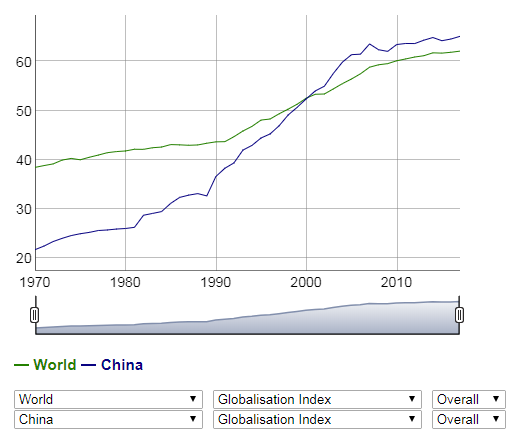The KOF Globalisation Index and its derivatives, e.g. used in Bertelsmann Stiftung studies, are a per-country measure with several components:
three sub-indices: the economy (weighting: 60 percent),
social dimensions and politics (weighting: 20 percent each).
The Economy sub-index provides indicators for crossborder ties in the areas of trade in goods and services as well
as wages and capital flows. The transaction metrics also
include transaction restrictions and capital controls. The
social dimension includes indicators for cultural proximity
and personal contacts, among others. Political globalization
is also reflected in a third sub-index. This dimension takes
account of aspects such as the number of international
treaties or membership in international organizations.
As it is designed, the index tends to "favor" (i.e. giver higher scores) to EU countries because they are counted separately but obviously have close ties with each other. In contrast, China gets a relative low score in this index because the measures are also taken in proportion to the country's economy and China's isn't as integrated with the rest of the world...
it is necessary to remember
that transaction metrics are not absolute values, but rather
stand in relation to economic output. This calculation is
necessary for producing the index so that different sized
economies can be compared. For the second-largest
economy in the world, this relative method tends to lead
to lower scores, among others for portfolio investments
(7% of GDP – 42nd place), for foreign direct investments
(23% of GDP – 41st place) and for trade in services (6% of
GDP – 40th place). Even in trade, the export nation of China
occupies only 38th place with an export volume of 31%
relative to gross domestic product.
Generally speaking, the index has shown consistent and correlated growth among countries:

The 2019 revised edition of the KOH index now distinguishes between "de facto" and "de jure" globalisation, but also aggregates them as one figure, eventually.
While de facto globalization measures actual international flows and activities, de jure globalization measures policies and conditions that, in principle, enable, facilitate and foster flows and activities. Quinn et al. (2011) show, for example, that the decision to use either de facto or de jure measures of financial openness gives rise to systematically different findings in the financial openness-economic growth nexus. [...]

The home page of the index has some interactive world maps and graphs. Playing a bit with that, China mirrors the world average (well it's a bit above it but roughly tracks/influences it) since the year 2000 or so.








